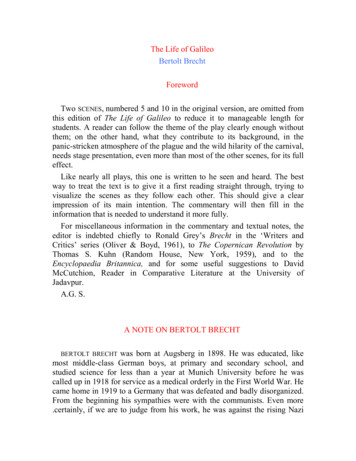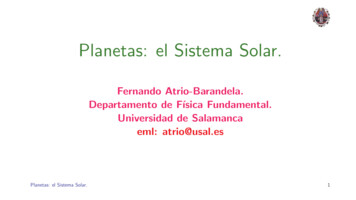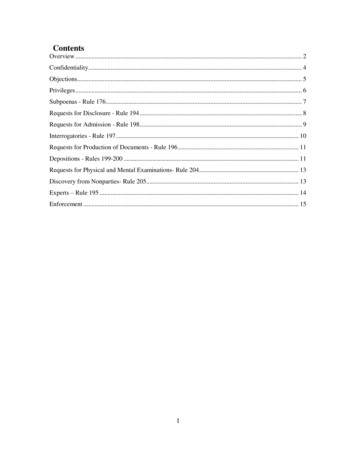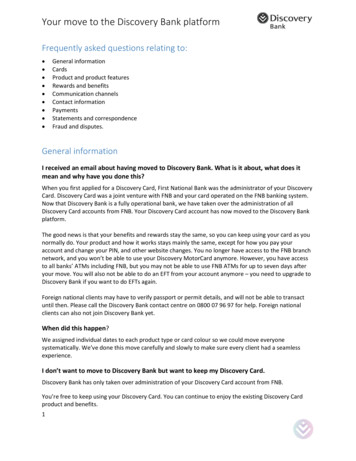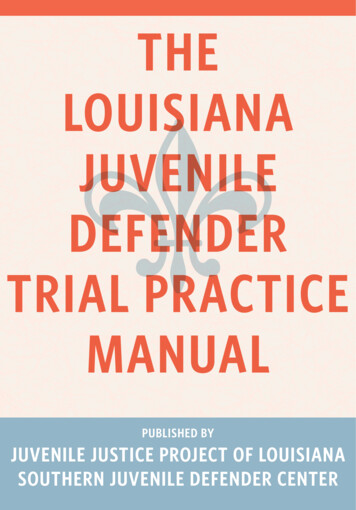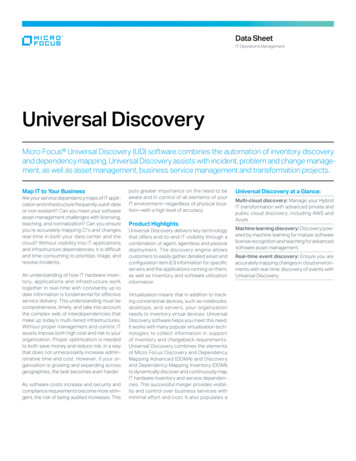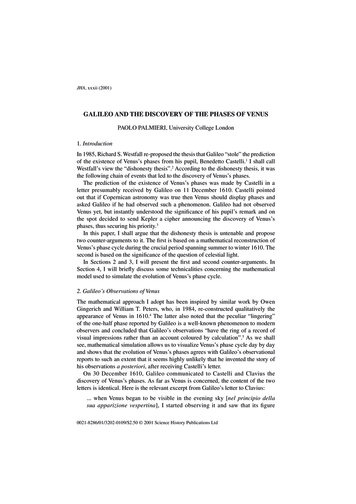
Transcription
JHA, xxxii (2001)GALILEO AND THE DISCOVERY OF THE PHASES OF VENUSPAOLO PALMIERI, University College London1. IntroductionIn 1985, Richard S. Westfall re-proposed the thesis that Galileo “stole” the predictionof the existence of Venus’s phases from his pupil, Benedetto Castelli.1 I shall callWestfall’s view the “dishonesty thesis”.2 According to the dishonesty thesis, it wasthe following chain of events that led to the discovery of Venus’s phases.The prediction of the existence of Venus’s phases was made by Castelli in aletter presumably received by Galileo on 11 December 1610. Castelli pointedout that if Copernican astronomy was true then Venus should display phases andasked Galileo if he had observed such a phenomenon. Galileo had not observedVenus yet, but instantly understood the significance of his pupil’s remark and onthe spot decided to send Kepler a cipher announcing the discovery of Venus’sphases, thus securing his priority.3In this paper, I shall argue that the dishonesty thesis is untenable and proposetwo counter-arguments to it. The first is based on a mathematical reconstruction ofVenus’s phase cycle during the crucial period spanning summer to winter 1610. Thesecond is based on the significance of the question of celestial light.In Sections 2 and 3, I will present the first and second counter-arguments. InSection 4, I will briefly discuss some technicalities concerning the mathematicalmodel used to simulate the evolution of Venus’s phase cycle.2. Galileo’s Observations of VenusThe mathematical approach I adopt has been inspired by similar work by OwenGingerich and William T. Peters, who, in 1984, re-constructed qualitatively theappearance of Venus in 1610.4 The latter also noted that the peculiar “lingering”of the one-half phase reported by Galileo is a well-known phenomenon to modernobservers and concluded that Galileo’s observations “have the ring of a record ofvisual impressions rather than an account coloured by calculation”.5 As we shallsee, mathematical simulation allows us to visualize Venus’s phase cycle day by dayand shows that the evolution of Venus’s phases agrees with Galileo’s observationalreports to such an extent that it seems highly unlikely that he invented the story ofhis observations a posteriori, after receiving Castelli’s letter.On 30 December 1610, Galileo communicated to Castelli and Clavius thediscovery of Venus’s phases. As far as Venus is concerned, the content of the twoletters is identical. Here is the relevant excerpt from Galileo’s letter to Clavius:. when Venus began to be visible in the evening sky [nel principio dellasua apparizione vespertina], I started observing it and saw that its figure0021-8286/01/3202-0109/ 2.50 2001 Science History Publications Ltd
Paolo Palmieri110Superior conjunction May 1610Superior conjunction December 1611Galileo beginsobservations1 OctGalileo’s answerto Castelli30 DecFIG. 1. Galileo’s observations of Venus. The three-month period of Galileo’s observations, from 1October to 30 December 1610, is clearly marked by the dotted lines. Grey areas representthe illuminated parts of Venus. Both size and phase are represented in accordance with mymathematical model. Sizes are to be compared with each other. The images do not reproduce theabsolute dimensions that Galileo would have seen through his telescope, but simply dimensionsrelative to each other. The line separating the dark zone from the zone illuminated by the Sun isan ellipse (cf. Section 4). Finally, note that I have assumed that Venus orbits the Sun along theecliptic. Details on the mathematics used are given in Section 4.was circular, though extremely small. Afterwards, I saw [Venus] growingin magnitude significantly, though always maintaining its circular shape.Approaching maximum elongation [digressione], [Venus] began to lose itscircular shape on the other side from the Sun and within a few days had acquireda semicircular shape. This shape it maintained for a number of days. Moreprecisely, it maintained [this shape] until it began to move towards the Sun,slowly abandoning the tangent. It now begins to assume a notable corniculateshape. Thus, it will continue to decrease during the period in which it remainsvisible in the evening sky.6First of all, when did Galileo begin to observe Venus? On the one hand, Galileotold Clavius that he had started his observations “when Venus began to be visible inthe evening sky”. On the other, he told Castelli that he had started his observationsabout three months earlier, that is, at the beginning of October.7 But it is clearthat “when Venus began to be visible in the evening sky” cannot coincide with thebeginning of October. To explain this discrepancy we need to consider Venus’sphase cycle in 1610 (Figure 1).Figure 1 presents an overview of the variation in Venus’s phase and magnitude,
111Galileo and Venusfrom the superior conjunction of May 1610 to the superior conjunction of December1611. Both apparent size and phase varied enormously, though not following auniform pattern of change. Galileo’s expression “when Venus began to be visiblein the evening sky” can only refer to some time in the late spring or early summerof 1610. On the other hand, the expression “[a]fterwards I saw [Venus] growing inmagnitude significantly, though always maintaining its circular shape” must referto a period after the beginning of October since a significant growth in magnitudebecame apparent only after the beginning of October. It is quite possible thatGalileo’s first observations of Venus might have begun in a rather casual way whenVenus had just emerged from the superior conjunction with the Sun. Perhaps, inhis reply to Castelli, Galileo decided to leave aside his first casual observations andfocus on the more recent ones.8 This conclusion is consistent with the fact that thesubstance of the two letters is absolutely identical. Thus, we can assume that Galileobegan (according to the wording of the reply to Castelli) or resumed (according tothe letter to Clavius) his systematic observations of Venus’s phases about 1 October1610 (see Figure 2 for the configuration of the planets on 1 October).To reconstruct Venus’s phase cycle during Galileo’s period of observation,we need to know with sufficient precision a second item of information, namelythe date of Venus’s maximum elongation. We can mathematically establish thatmaximum elongation was reached between 10 and 20 December (see Section 4for a discussion of this point). This allows us to infer that the period referredto by Galileo as “approach to maximum elongation” lasted for some time priorto some particular day between 10 and 20 December 1610 (how long it lastedwe shall see in a moment). Figure 3 gives the phases on 10 and 20 December,when Venus finally passed maximum elongation and started becoming crescent.We can now turn to showing that Galileo’s report matches the reconstructionof Venus’s cycle.Let us re-call Galileo’s words,I saw [Venus] growing in magnitude significantly, though always maintainingits circular shape . and within a few days [Venus] had acquired a semicircularEARTHSUNMERCURYVENUSFIG. 2. The configurations of the planets on 1 October 1610.
112Paolo PalmieriFIG. 3. The passage of Venus’s phase from slightly gibbous to slightly crescent. The first figure isVenus on 10 December 1610, the second figure Venus on 20 December (sizes are relativeto each other).shape. This shape it maintained for a number of days . it maintained [this shape]until it began to move towards the Sun, slowly abandoning the tangent.9Thus, Galileo observed two patterns:(a) Venus growing in magnitude and remaining circular for some time beforeundergoing the change in phase that it displays during the approach tomaximum elongation, and(b) Venus “lingering over” the semicircular phase, that is, the peculiar fact thatVenus maintains an approximate semicircular shape for a number of days (theduration of this “lingering” phenomenon was about one month, according to amore precise piece of information Galileo furnished subsequently).10These are the patterns Galileo’s telescope allowed him to observe from October toDecember 1610 and these are the patterns that mathematical simulation confirm.In fact, not until late December was Venus to display a marked crescent (cf. Figure4).11 It is also clear that Galileo was unable to observe an appreciable change fromcircular to semicircular shape until at least the first half of November, becausehe tells us that the “lingering” phenomenon lasted about a month and that Venus“maintained [the semicircular shape] until it began to move towards the Sun,slowly abandoning the tangent”, i.e. slowly abandoning maximum elongation(which occurred between 10 and 20 December). Therefore, what Galileo calls“approach to maximum elongation” must have begun in the first half of Novemberand lasted about a month.As to pattern (a), it must be noted that even though mathematical reconstructionshows Venus clearly gibbous already on 30 October, Galileo interpreted its shapeas circular during all the first part of his period of observation, that is until aboutmid-November (cf. Figure 4).To understand pattern (b), we need to consider the whole pattern of change thatGalileo was confronted with during Venus’s approach to maximum elongation, andthis is shown in Figure 5. During the first half of November, Venus’s phase turned
Galileo and Venus113F IG . 4. Venus’s shape on 30 September, 30 October and 30 December 1610 (sizes are relativeto each other). For at least the first month of observations, Galileo attributed to Venus acircular shape.from markedly gibbous into nearly semicircular and remained approximately suchuntil maximum elongation, producing the “lingering” phenomenon.Furthermore, when patterns (a) and (b) are together compared with the phasesequences of Figure 4 and Figure 5, they reveal another characteristic that isessential in order to establish the truthfulness of Galileo’s claims. Patterns (a) and(b) are exaggeratedly non-linear.How can this exaggeration be explained? In all probability, the limitations ofGalileo’s telescope are responsible for his tendency to overestimate the duration ofthe type of phase he could recognize.12 In other words, these limitations may havecaused an exaggeration of the non-linear effects that Galileo so clearly describes.The resolving power of his telescope was not sufficient to allow him to observe theslow change from moderately gibbous to semicircular (cf. the final images of Figure5). This explains why he saw Venus circular until mid-November and reckoned thatFIG. 5. The variation of Venus’s phase and dimension during the approach to maximum elongation(sizes are relative to each other).
Paolo Palmieri114VENUSEARTHSUNVENUSFIG. 6. A qualitative representation of Venus’s phases in a simplified version of the Ptolemaic systemwhen Venus is always below the Sun (Venus always below the Sun simply implies that Venus’sepicycle is between the Earth and the Sun, cf. Fig. 8 for a three-dimensional picture). It hasbeen assumed that the Earth’s centre, the centre of Venus’s epicycle and the Sun’s centre lieon a straight line. By imagining placing the Sun between the Earth and the Venus epicycleon the line joining the Earth’s centre and the centre of Venus’s epicycle, the reader canvisualize the mechanics of the phases when Venus is always above the Sun (always abovethe Sun simply means that the Sun is between the Earth and Venus’s epicycle, cf. Fig. 8 fora three-dimensional picture).the duration of the “lingering” phenomenon extended over a period of about onemonth. Clearly, this exaggeration can only have been the result of real astronomicalobservations. Theoretical prediction on the sole basis of Copernican faith wouldalmost surely have led him to assume a more ‘natural’ pattern of behaviour, i.e. alinear one. And this leads us to Galileo’s wait for Venus’s crescent phase.Galileo decided to wait until the end of December before answering Castelli’sletter simply because until the end of December he was unable to discern clearly thecorniculate shape with his telescope. At the beginning of his period of observation(1 October), Galileo attributed to Venus a circular shape. He subsequently observedit as it assumed a semicircular shape and remained thus for a number of days. Henow wanted to ascertain that Venus would eventually become corniculate, for thishad profound implications for the Ptolemaic system.Contrary to Westfall’s opinion that “[a]t no point during December was its[i.e. Venus’s] shape compatible with the Ptolemaic system”,13 during DecemberVenus’s phase cycle in fact showed nothing incompatible with Ptolemy’s systemat any single point, except at maximum elongation, where Venus reaches the exactsemicircular phase. In the Ptolemaic system, the perfect semicircular phase is thelimit situation to which Venus’s phase tends without ever reaching it. If Venus werealways below the Sun (i.e. if Venus’s epicycle were between the Earth and the Sun),then Venus should clearly display a pattern of phases similar (but not identical) to
Galileo and Venus115centre of Venus’sepicycle below theSunFIG. 7. The pattern of Venus’s phases in a simplified version of the Ptolemaic system, in whichVenus is always below the Sun. For the mathematics cf. Section 4. Venus’s sizes are relativeto each other.centre of Venus’sepicycle above theSunFIG. 8. Venus’s phases in the Ptolemaic system when Venus is always above the Sun. For the mathematicscf. Section 4. Venus’s sizes are relative to each other. Note that a slightly gibbous phase becomesappreciable only when Venus approaches inferior conjunction.
Paolo Palmieri116Light fromthe SunMOONEARTHFIG. 9. A simplified model of the Moon at quadrature.the pattern visible in late December 1610 (a pattern of crescent phases, cf. Figures 6and 7). If Venus were always above the Sun (i.e. if the Sun were between the Earthand Venus’s epicycle), then its phase should always be nearly circular or gibbous(Figure 8). This being so, until Venus reaches at least the semicircular phase,astronomical observation cannot prove that it descends below the Sun. Galileo wasperfectly aware that Venus could be thought always to remain above the Sun, for inFebruary 1611 he wrote to the Servite friar, Paolo Sarpi, that[w]e are now certain that Venus orbits the Sun, neither [revolving] below (asPtolemy believed), where it would always show [a phase] less than one halfof a circle, nor above (as Aristotle fancied), since if it were above the Sunone would never observe it crescent, but always much more than one half andalmost always perfectly circular.14What is truly incompatible with Ptolemy’s system is the fact that Venus issometimes above the Sun and sometimes below the Sun. While, as we have seen,in the Copernican system, Venus can be gibbous both before and after quadrature,it can be crescent only after quadrature, when it is between the Earth and the Sun.I believe that here Westfall may have been misguided by a ‘linear’ interpretation:he inadvertently supposed that the point of Venus’s orbit at which the planet’sphase turns from gibbous into crescent is the quadrature (as is approximatelytrue for the Moon, cf. Figure 9).If the passage from gibbous to crescent were at quadrature, then this change ofphase would truly be incompatible with Ptolemy’s system, since the quadraturecoincides with the point at which Venus leaves the part of the orbit beyond the Sun toenter the part between the Earth and the Sun. In this case, one could probably arriveat Westfall’s conclusion that Venus’s phase would at no point during December1610 have been compatible with Ptolemy’s system. But Venus’s phase cycle is
117Galileo and VenusVenus at quadratureVenus at maximumelongation is belowthe SunEARTHSUNVenus above the SunFIG. 10. Venus at maximum elongation, at quadrature, and beyond the Sun, in a simplified versionof the Copernican system.different from that of the Moon (cf. Figure 10).As Galileo clearly pointed out to Paolo Sarpi, the crucial change in phasefor Ptolemy’s system is the passage from circular or nearly circular shape tocrescent. A variant of Ptolemy’s system with Venus always above the Sun couldstill accommodate the passage from nearly circular to gibbous.15 At the beginningof his period of observation, Galileo had seen Venus showing the circular phase. Heneeded to see it assuming the crescent phase. When, towards the end of December,he satisfied himself that indeed Venus had started assuming the crescent phase, hebroke his silence and wrote his letters to Clavius and Castelli.In summary, Castelli’s letter cannot have been the spark that ignited Galileo’sprogramme of observation of Venus. It was simply too late. If he only then hadstarted observing Venus, he would have seen it already nearing the exact semicircularphase, thus completely missing the non-linear patterns of change. And he could notpossibly have been able to calculate the duration of one month for the “lingering”phenomenon. In other words, Galileo cannot have predicted Venus’s non-linearpatterns of behaviour by re-constructing them ‘backwards’. For a Copernican itmight have been easy to predict that Venus should display phases. However, it isone thing to predict this type of behaviour qualitatively and quite another to predictthe non-linear patterns of change of Venus’s phases. A quantitative analysis wouldhave required of Galileo a sophisticated mathematical theory that he did not have.There remains only one possibility, namely, that Galileo really did observe Venus’snon-linear patterns of behaviour.3. The Discovery of Venus’s Phases and the Question of Celestial LightWestfall argues that on 11 December 1610, Galileo, prompted by Castelli’sprediction, sent Kepler the cipher announcing “his” discovery of Venus’s phases,
118Paolo Palmierieven though he had not yet observed Venus.16 This interpretation of the episodeof the cipher is totally implausible, even if Stillman Drake’s opinion that Galileowished to avoid the risk of being anticipated by another astronomer were true.17 Tosee why, we need to turn to the consequences — not considered by the dishonestythesis — that the discovery of Venus’s phases had for the debate on the natureof celestial light.Owen Gingerich noted that the round, disk-like appearance first observed byGalileo was incompatible with the Ptolemaic system if Venus shone by reflectedlight, but pointed out that “until the phases began to appear he [Galileo] couldnot rule out the possibility that Venus shone by its own light .”.18 I shall furtherdevelop Gingerich’s argument, showing that Galileo was indeed deeply concernedwith the long-debated question of celestial light and fully aware that his discoverywas potentially able to settle it. To substantiate this line of reasoning in a properhistorical context, I will consider two contemporary responses to Galileo’s discoveryof Venus’s phases in connection with the question of celestial light, one from aCopernican and one from an anti-Copernican point of view. More specifically, Iwill examine the hitherto unstudied reactions to Galileo’s observations of Venusby Kepler and by Scipione Chiaramonti, the then famous Aristotelian attacked byGalileo in the Dialogue concerning the two chief world systems. Both Galileo’sawareness of the implications of the phases and Kepler’s and Chiaramonti’sreactions strongly suggest that celestial light was still a totally open questionand that, when Galileo sent Kepler the cipher on Venus, he would not havestaked his reputation on Castelli’s purely theoretical prediction without a reliableobservational basis.Edward Grant has furnished a detailed account of the status quaestionis ofcelestial light from the late Middle Ages to the seventeenth century.19 Scholasticauthors were divided on this issue. Albert of Saxony, for example, attributed toAristotle and Averroës the conviction that the Sun was the sole source of light, andto Macrobius and Avicenna the idea that the Moon received light from the Sun, butthat all the other planets and stars are self-luminous.20 However, Albert of Saxonyand Nicole Oresme thought that the question could not be determined, though theyfavoured Aristotle’s and Averroës’s opinion. It is worth noting that the predictionof phases was made in the Middle Ages. According to Grant, “supporters of theAvicennan and Macrobian position argued that if all the planets had their light fromthe Sun and possessed none of their own, planets ought to exhibit variations in light— that is they ought to undergo phases — just as the Moon does”.21The question of celestial light did not simply concern the difference betweenopaque bodies that reflected solar light and self-luminous bodies. In fact, the mostcommon opinion (adopted by Albertus Magnus and Albert of Saxony) assumedthat planets and stars “were transparent and could therefore receive solar lightthroughout the extent of their bodies”.22 In other words, planets and stars wouldbe visible to us because their bodies are impregnated with solar light that theysubsequently transmit to us. In addition to the light received from the Sun, Albert
Galileo and Venus119of Saxony conceded that the planets might possess some light of their own. Thismixed theory became more and more popular during the sixteenth and seventeenthcenturies.23 At the end of the sixteenth century, the Coimbra Jesuits summarized thisposition by declaring that “the more common assertion of the astronomers is thatboth the fixed stars and the planets receive their light from the Sun but neverthelesspossess some light by themselves”.24Yet during the late sixteenth and early seventeenth centuries the discussion onthe nature of celestial light became more complex. Thus we find the Jesuit GiovanniBattista Riccioli, in his Almagestum novum — a monumental astronomical treatisepublished in 1651 — discussing in detail four major theories that were still currentamongst his contemporaries.25 Galileo himself, in the Third Day of the Dialogueconcerning the two chief world systems, mentioned the argument from luminosityas Copernicus’s explanation for the lack of apparent change in size and shape ofVenus when observed with the naked eye. According to Galileo, it was preciselybecause of this lack of observational evidence that Copernicus “declared that Venuswas either luminous in itself or that its substance was such that it could drink in thesolar light and transmit this through its entire thickness in order that it might lookresplendent to us”.26 But Galileo was wrong in attributing to Copernicus a firm opinionconcerning the light of Venus, as has been shown by Edward Rosen.27This résumé should suffice to prove that the question of celestial light was aliveand well in Galileo’s time and afterwards.28 To understand why Galileo thought hisdiscovery was relevant to the issue of celestial light we need to turn to letters hesent Kepler via the Medici ambassador in Prague. In these letters, Galileo expandedon the question of celestial light.In the letter of 1 January 1611, Galileo revealed the meaning of the cipher andasserted that the discovery of Venus’s phases had eventually afforded “certa esensata dimostratione” of two “great questions”: (1) that all planets are opaque[tenebrosi] by nature, and (2) that Venus revolves around the Sun.29 Galileo alsostressed that the first of these questions had remained until then unresolved and hadresisted the efforts of the greatest minds.30Kepler immediately acknowledged the significance of Galileo’s observationsin relation to celestial light. In the Preface to his Dioptrice (1611), he publishedGalileo’s letters of 13 October 1610, 11 December 1610, 1 January 1611, and 26March 1611.31 Commenting on Galileo’s letter of 1 January 1611, Kepler marvelledat the fact that Venus could shine more than Jupiter simply by reflecting solar light.On the basis of some experiments of his own concerning a discernable variationin Venus’s light caused by various modes of winking the eye, and which he hadpreviously expounded in his Astronomiae pars optica (1604), he ventured tohypothesize that “there is no escaping the conclusion that the star of Venus revolvesaround its own axis most swiftly, showing in succession the various parts of itssurface that are more or less receptive to solar light”.32But the discovery of the phases spurred Galileo to theorize about the light comingfrom far beyond the sphere of Venus. In his letter of 26 March 1611, he raised
120Paolo Palmierithe issue of the adventitious irradiation surrounding the bright objects visiblethrough the telescope.33 He now asserted that he had “certa dimostratione” thatnot only the planets are opaque and receive their light from the Sun, but that thefixed stars shine by their own light. It is worth quoting in its entirety the relevantexcerpt from Galileo’s letter.The principle argument of my discourse derives from the telescopic observationthat the nearer the planets are to the Sun, or to us, the more light they receive[from the Sun] and reflect towards us. Thus Mars, at its perigee, when it isnearest to us, is seen much brighter than Jupiter, though its size is less thanJupiter’s and one can hardly deprive it of the irradiation that prevents us fromobserving its disk bounded and round. Now, since we clearly see that the Sungreatly illuminates Mars when it is near, while the light from Jupiter is muchweaker ., and that of Saturn most weak and darkened, since the latter is muchfurther [from us], how should the fixed stars, incredibly further [from us] thanSaturn, appear, if they received light from the Sun? Very weak indeed. Yetthe opposite is true. Thus I believe that we should philosophize correctlyand assign the cause of the scintillation of the fixed stars to the vibration ofthe splendour native to their intimate substance, whereas on the surface of theplanets the light coming from the Sun terminates and is reflected.34In Galileo’s view, both the planets and the fixed stars show some irradiation. Butwhile that of the planets is adventitious — though in the case of Mars the telescopecan hardly eliminate it — that of the stars is “native to their intimate substance”and therefore cannot be eliminated. So, the stars shine because they emit light andtheir scintillation derives from the “vibration” of their light, whereas the planetsare opaque and can only shine because they receive light from the Sun. But why isirradiation observed even in the planets, and where does it actually form? EvidentlyGalileo does not have the answer yet. This difficulty, however, did not prevent Keplerfrom clearly recognizing the cosmological significance of the relationship betweenVenus’s phases, the opacity of the planets’ bodies, and celestial light. He concludedhis comments on Galileo’s letters on Venus and celestial light with an elegantsimile that incorporated a reference to both the “sensate esperienze” and the “certedimostrazioni” of Galileo’s method. “Galileo’s mind”, says Kepler,by using the telescope like a ladder, ascends the highest and ultimate wallsof the visible universe, perlustrates everything directly, and with most subtlereasoning looks down on our shacks, the planetary bodies, comparing theoutermost with innermost [things], the highest with the lowest [things], bymeans of solid arguments.35The implications of Galileo’s discovery of Venus’s phases for the questionof celestial light were perfectly understood even in the anti-Copernican field.36Scipione Chiaramonti (1565–1652) — better known for his opposition to Galileo,Kepler, and Tycho — was a polymath and an Aristotelian natural philosopher who
Galileo and Venus121prided himself on being knowledgeable about mathematics.37 He wrote a interestingtract on the phases of the Moon (published posthumously), in which he showednotable mathematical competence.38 The force of the impact of Venus’s phasesand light on Chiaramonti’s Aristotelianism is revealed by the shift that it causedin his epistemology, from the rigorously Aristotelian position he put forward inthe anti-Galilean Difesa of 1633 (against Galileo’s Dialogue) to the somewhatunorthodox conclusions reached in the De universo of 1644.39In 1633, Chiaramonti pledged full allegiance to the Aristotelian principle ofthe certainty of sense experience. It was on this purely Aristotelian basis that herejected the reliability of the telescope.I attribute to the senses, absolutely considered, though in their appropriatedisposition, at the convenient distance, and within a pure medium, the rightjudgement of their object. This is necessary [to save] the evidence of principlesand of the demonstrations dependent on principles. On the other hand, he[i.e. Galileo] attributes to the occhiale, or telescope, incorruptible truth andperfection, and an increase in the power of sight. Yet the contrary is true,because this instrument is based on refraction, which invariably causes somedeception, sometimes enormously distorting appearances.40In this passage, Chiaramonti sees a conflict between what can be perceived throughthe senses “in their appropriate disposition, at the convenient distance, and withina pure medium” (Venus does not show phases to the naked eye) and what is“constructed” through the telescope (the phases). But, for Chiaramonti, in orderto save the whole fabric of Aristotelian science, the certainty of sense experiencecannot be called into question and the telescope must be rejected. It is refraction thatexplains the illusory telescopic appearances. Thus, Chiaramonti’s strict adherenceto the Aristotelian principle of the certainty of sense experience rules out thepossibility of accepting the telescope.A few years later, in De universo, Chiaramonti’s position had changedconsiderably. He begins by noting that it is extraordinary that phases not observableby the naked eye become visible with the telescope; even
Galileo's fi rst observations of Venus might have begun in a rather casual way when Venus had just emerged from the superior conjunction with the Sun. Perhaps, in his reply to Castelli, Galileo decided to leave aside his fi rst casual observations and focus on the more recent ones.8 This conclusion is consistent with the fact that the


